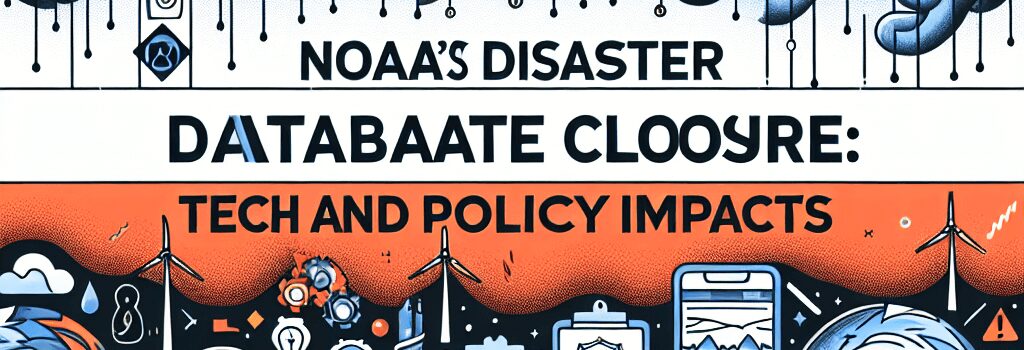NOAA’s Disaster Database Closure: Tech and Policy Impacts

On May 8, 2025, the National Oceanic and Atmospheric Administration (NOAA) abruptly announced it would discontinue updates to its flagship “Billion-Dollar Weather and Climate Disasters” database. Established in 1980, this dataset has tracked the direct economic costs of 403 U.S. extreme weather events—tornado outbreaks, hurricanes, wildfires, heat waves, floods—totaling at least $2.945 trillion in damages. NOAA’s decision follows steep staff cuts under the current administration and raises significant concerns across climate science, data infrastructure, and emergency management communities.
Scope of the Database and Historical Impact
The Billion-Dollar Disaster database aggregates loss estimates from federal agencies, insurance companies, state emergency management offices, and peer-reviewed scientific publications. It provides:
- Event-level metadata (date, location, intensity metrics such as wind speed, precipitation totals or fire acreage damaged).
- Economic loss figures normalized to current-year dollars leveraging the Consumer Price Index (CPI) and National Income and Product Accounts for inflation adjustment.
- Socioeconomic vulnerability overlays (population age, median household income, disability rates) at the county level.
Because the dataset is public, researchers and policymakers have applied it to:
- Develop catastrophe risk models in R and Python, using libraries like
scikit-learnandstatsmodels. - Train AI-driven early-warning systems on satellite and radar feeds, correlating hazard signals with historical loss outcomes.
- Inform FEMA grant allocations and state-level resilience planning.
Administration Rationale and Technical Implications
In an internal memo, NOAA’s National Centers for Environmental Information (NCEI) cited “evolving priorities, statutory mandates, and staffing constraints” as reasons for halting data collection after 2024. The announcement assured stakeholders that archives from 1980–2024 would remain “authoritative, archived, and accessible,” but omitted any reference to maintaining the underlying data pipelines or API endpoints that power major cloud-hosted services.
Key technical details impacted include:
- Data Pipeline Discontinuation: Automated ETL scripts in Python/SQL that ingested FEMA, National Weather Service, and State Emergency Agency feeds will no longer run. Cron jobs hosted on NOAA’s AWS GovCloud environment will be decommissioned.
- API Endpoint Shutdown: The RESTful API served via
nginxand containerized with Docker on Kubernetes clusters will be retired. Applications querying/billion_disasters/v1/eventsendpoints will receive HTTP 410 (Gone) errors. - Data Format Archival: Historical datasets in NetCDF and CSV stored on NCEI’s tape library and Amazon S3 buckets will be set to “cold storage,” potentially incurring longer retrieval times and higher fees via Glacier retrieval processes.
Impact on AI, Climate Research, and Emergency Management
Dr. Marianna Parsons, a senior scientist at the University Corporation for Atmospheric Research (UCAR), warned that “training machine learning models on out-of-date or partial data introduces significant bias and undermines predictive performance. The inability to access up-to-the-minute loss estimates will impair real-time analytics for event attribution and economic impact forecasting.”
Within the private sector, catastrophe modeling firms (e.g., RMS, AIR Worldwide) hold proprietary loss databases, but these are inaccessible or prohibitively expensive for local governments and academic teams. As a result, many applied AI research projects—such as convolutional neural networks analyzing Doppler radar echoes for hail damage prediction—will lose their most reliable ground-truth labels.
Emergency management agencies, which rely on cloud-based dashboards hosted on Azure and Google Cloud Platform, face gaps in automated situational awareness tools. Without updated loss metrics, dashboards that trigger automatic resource dispatch based on predefined thresholds (for example, costs exceeding $500 million) may fail to activate critical response protocols.
Prospects for Private, Academic, and Open-Source Alternatives
Some nonprofit initiatives are stepping forward to fill the void. The Climate Markets & Investment Association has begun assembling an open-data coalition that leverages AWS Open Data Sponsorship and Google Public Datasets, aiming to mirror NOAA’s functionality using crowdsourced reports, satellite-derived damage assessments, and insurance claims scrapes.
However, replicating NOAA’s archival depth poses challenges:
- Data Licensing: Commercial insurers restrict redistribution of claim-level data, and state agencies vary in public-records transparency.
- Standardization: NOAA enforced strict data schemas and metadata standards (ISO 19115 geospatial metadata) that ensure interoperability—efforts which take years to codify in new frameworks.
- Funding and Maintenance: Sustained operations at scale demand multi-million-dollar budgets for cloud compute (estimated at $150k/year for continuous ETL on AWS) and expert personnel in data engineering.
Policy, Oversight, and Future Directions
Congressional oversight hearings are being scheduled by the House Committee on Science, Space, and Technology to examine the broader impact of NOAA funding cuts on national resilience. Legislators are exploring bipartisan bills that would codify the billion-dollar database into law, preventing future administrations from unilateral closures.
Meanwhile, climate data advocacy groups encourage citizens and state officials to submit public comments to ncei.orders@noaa.gov. They also propose leveraging the Federal Data Strategy to mandate baseline service levels for all critical datasets designated as “Essential Dataset.”
Expert Perspectives
- Dr. Ravi Singh, Data Science Lead at CarbonPlan: “Open, updated loss data is foundational not just for climate finance but for equitable adaptation planning in vulnerable communities.”
- Jennifer Alvarez, CIO of Texas Division of Emergency Management: “Our flood response algorithms used NOAA’s latest dataset to predict shelter needs. Losing that feed undermines operational readiness.”
- James Chen, Senior Analyst at TechPolicy Labs: “This decision highlights the fragility of public data infrastructures and the need for resilient, multi-stakeholder ecosystems.”